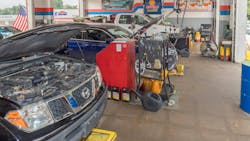When a young customer walks in the door to get service—be it a teenager or twenty-something—it's not necessary to automatically assume the driver has no knowledge of the service needed. A service writer should quickly assess when more explanation is needed.
Young Drivers
Each customer who comes in the shop should get the same greeting, with no preconceived notions of age, driving experience, gender, or other attributes.
"We treat (young drivers) like any other customer during the greeting," explains Brian Hahs, operations manager at Charlie's Fast Lube in Jackson, Missouri.
A service writer's response can quickly change once the conversation begins. If a driver seems inexperienced at getting an oil change, or unaware of how to handle service issues, it might be time for some handholding.
"We spend more time during the qualification process to make sure they understand what they are purchasing," Hahs tells NOLN. If there is still a disconnect, some younger drivers may be advised to bring in reinforcements. "We ask if we should have any conversation with their parents if they seem really young."
Address Customer Needs, Young and Old
There may be times when even experienced drivers need a more detailed explanation of service when it's an issue, they are unfamiliar with. Advisors should be prepared to break down service details from listing the service to summarizing what needs to be done, and even be prepared to give a brief lesson on the service that is required.
Every customer should go home with information about what work was done, and whenever possible what work will be needed down the road.
"I feel like we do a good job of explaining our recommendations no matter what the age," says Hahs. "We make sure and send them home with a sheet that shows all recommendations, an explanation of each service with recommended mileage and price of service."
When there are knowledge gaps, a service writer should be prepared to offer information to be helpful, but not patronizing.
"Most younger people are not familiar with the different types of oils and weights. They do not know what's best for their car," Hahs points out. "I believe they would like to have more information but are embarrassed to ask or don't know what to ask. We have to be retroactive and give those explanations right on the spot."
Every shop will have a strategy for how to field situations, such as dealing with what type of oil is preferred. Initiative is recommended.
"We never ask our customers what type of oil they want. Most don't know. We show them the cap off their vehicle and recommend accordingly,” Hahs says. “I believe they feel better when we take control of the sale."
The most important strategy is to build customer confidence in the shop by being straightforward with explanations and offering more information when it's needed.
"Our younger customers are uneducated when it comes to vehicle maintenance. We are the professionals. That's why they come to us," Hahs says. "We need to plant the seed when it comes to taking care of their car. If we don't, who will?"
Build Loyalty While They're Young
Build your customer base by establishing loyalty programs, educating customers on required services, and reaching out to customers on platforms and with methods they use, such as social media, text, and other messaging.
"We offer our text and email program," explains Hahs. "Not only does it give them a reminder, but it gives them some coupons as well. We also send a reminder about the declined services with a special attached. We send a text thanking them for coming and ask them if they'd take time to give us a review. They are usually pretty good about doing that."
Email and text are good channels to reach customers, but a presence on social platforms could make the shop more relatable. It's another method for reaching your customer and providing information to educate them so they come in armed with the knowledge they need for their required service.






